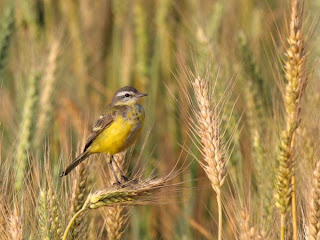The winter of 08-09 has now packed away its woollies and headed off into the southern hemisphere to cool things off. But while we argued about the patterns of bird migration, the late arrival of migrants (some entirely absent) and blamed global warming for our frustrations, a biologist I know has braved the odds and conducted one of the most comprehensive bird surveys conducted in Uttar Pradesh in recent times.
 Streams in the agricultural landscape make excellent foraging grounds for a variety of waterbirds.
Streams in the agricultural landscape make excellent foraging grounds for a variety of waterbirds.
The man (not in picture) is Gopi Sundar, whom readers of this blog have met virtually many times over. Gopi, as the International Crane Foundation's research associate and principal coordinator of the Indian Cranes and Wetlands Working Group, is well known for his study of Sarus cranes and their habitat in the rice-dominated agricultural landscape of Uttar Pradesh. Gopi spent the winter braving dense fog and the political mafia to execute a painstaking survey of the bird diversity in this ecosystem. He used a grid-based sampling design with space-for-time replication to test for variations in "observed patterns of bird species richness and abundance due to four different intensities of rice cultivation". His study documented 198 bird species in 160 transects.
 Yellow Wagtails are a relatively common species in Uttar Pradesh's cultivated areas. They are one of the last migrants to leave and can be seen feeding on insects in ripening wheat fields in early summer.
Yellow Wagtails are a relatively common species in Uttar Pradesh's cultivated areas. They are one of the last migrants to leave and can be seen feeding on insects in ripening wheat fields in early summer.
Gopi's report begins with this arresting declaration: "Agriculture is the biggest threat to bird diversity worldwide."
The Hindu published a report based on his work in its national edition. It opens with the very same statement.
Gopi's findings suggests that agriculturists hark back to traditional land-use methods, which preserved natural habitats and enabled bird diversity. Preserving islands of natural habitat and avoiding mono-cropping or monocultures can be important steps in this direction.
The Hindu report can be read
here.
PHOTOGRAPHS: © K. S. GOPI SUNDAR/ ICF. USED WITH PERMISSION. ALL RIGHTS RESERVED.
 Streams in the agricultural landscape make excellent foraging grounds for a variety of waterbirds.
The man (not in picture) is Gopi Sundar, whom readers of this blog have met virtually many times over. Gopi, as the International Crane Foundation's research associate and principal coordinator of the Indian Cranes and Wetlands Working Group, is well known for his study of Sarus cranes and their habitat in the rice-dominated agricultural landscape of Uttar Pradesh. Gopi spent the winter braving dense fog and the political mafia to execute a painstaking survey of the bird diversity in this ecosystem. He used a grid-based sampling design with space-for-time replication to test for variations in "observed patterns of bird species richness and abundance due to four different intensities of rice cultivation". His study documented 198 bird species in 160 transects.
Streams in the agricultural landscape make excellent foraging grounds for a variety of waterbirds.
The man (not in picture) is Gopi Sundar, whom readers of this blog have met virtually many times over. Gopi, as the International Crane Foundation's research associate and principal coordinator of the Indian Cranes and Wetlands Working Group, is well known for his study of Sarus cranes and their habitat in the rice-dominated agricultural landscape of Uttar Pradesh. Gopi spent the winter braving dense fog and the political mafia to execute a painstaking survey of the bird diversity in this ecosystem. He used a grid-based sampling design with space-for-time replication to test for variations in "observed patterns of bird species richness and abundance due to four different intensities of rice cultivation". His study documented 198 bird species in 160 transects.
 Yellow Wagtails are a relatively common species in Uttar Pradesh's cultivated areas. They are one of the last migrants to leave and can be seen feeding on insects in ripening wheat fields in early summer.
Gopi's report begins with this arresting declaration: "Agriculture is the biggest threat to bird diversity worldwide." The Hindu published a report based on his work in its national edition. It opens with the very same statement.
Gopi's findings suggests that agriculturists hark back to traditional land-use methods, which preserved natural habitats and enabled bird diversity. Preserving islands of natural habitat and avoiding mono-cropping or monocultures can be important steps in this direction.
The Hindu report can be read here.
PHOTOGRAPHS: © K. S. GOPI SUNDAR/ ICF. USED WITH PERMISSION. ALL RIGHTS RESERVED.
Yellow Wagtails are a relatively common species in Uttar Pradesh's cultivated areas. They are one of the last migrants to leave and can be seen feeding on insects in ripening wheat fields in early summer.
Gopi's report begins with this arresting declaration: "Agriculture is the biggest threat to bird diversity worldwide." The Hindu published a report based on his work in its national edition. It opens with the very same statement.
Gopi's findings suggests that agriculturists hark back to traditional land-use methods, which preserved natural habitats and enabled bird diversity. Preserving islands of natural habitat and avoiding mono-cropping or monocultures can be important steps in this direction.
The Hindu report can be read here.
PHOTOGRAPHS: © K. S. GOPI SUNDAR/ ICF. USED WITH PERMISSION. ALL RIGHTS RESERVED.
